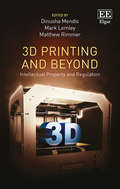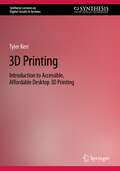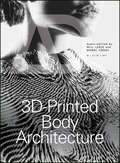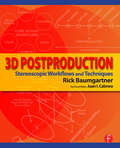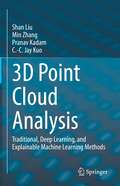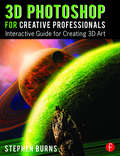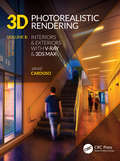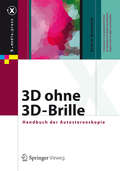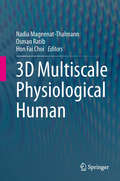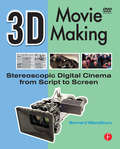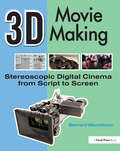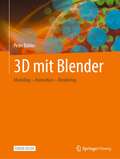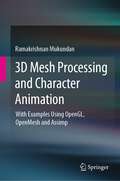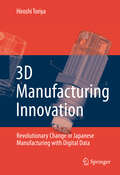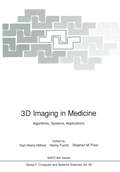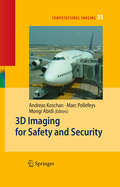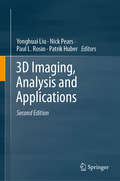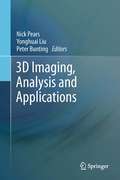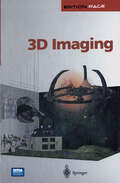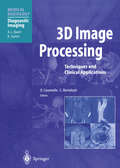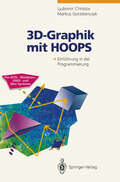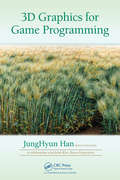- Table View
- List View
3D Printing and Beyond: Intellectual Property and Regulation
by Dinusha Mendis Mark Lemley Matthew RimmerThis ground-breaking and timely contribution in the field of intellectual property law explores the implications of 3D printing and additive manufacturing in three core jurisdictions: the UK, USA and Australia. Providing in-depth analysis of the current state of affairs, as well as outlining future issues and developments, 3D Printing and Beyond addresses both the challenges and opportunities created by 3D printing. Combining expertise from academia and practice, the original contributions to this book consider the regulation of new, emerging and future technologies and their implications for the legal landscape. The book goes beyond 3D printing and its relationship with intellectual property to the realms of ethics, contracts, socio-legal aspects and economics. Intellectual property academics will greatly benefit from reading this book, as it not only explores the myriad ways in which 3D printing has altered the horizon of intellectual property law, but also offers ideas for areas of future research. Practitioners and policy makers will also benefit from the useful examples and cases used in this book.
3D Printing: Introduction to Accessible, Affordable Desktop 3D Printing (Synthesis Lectures on Digital Circuits & Systems)
by Tyler KerrThis book is an introduction to the wide and varied world of 3D printing—an incredible technology used across an ever-growing list of industries. As 3D printing continues to skyrocket in popularity, it’s increasingly important to understand how these machines work and how to apply 3D printing technology to personal and professional interests. More important still, this book highlights how surprisingly easy 3D printers can be to use, even for readers who don’t consider themselves particularly tech-savvy. This book provides a comprehensive overview of 3D printing for first-time users. The text introduces some of the most popular types of 3D printing technology available, as well as some of the most exciting and compelling applications across industry today. The content dives deeply into one of the most popular and widely accessible 3D print technology on the market: fused deposition modeling (FDM) 3D printing. The reader will learn basic FDM 3D printer anatomy, software settings, as well as the tips and tricks to master your own FDM 3D printer. The book provides a firm understanding of what FDM 3D printing excels at, its current limitations, and how to troubleshoot and overcome some of the most common 3D printing problems. The book then provides some ‘STEAM-building’ cross-disciplinary challenges and applications for the reader to complete at home. This book is for novice readers who might be early in their 3D printing journey. For those looking to learn more about introductory 3D printing and curious about how to get started, this is an excellent place to start. By the end of the book, the reader should have all the understanding and tools necessary to start 3D printing with confidence.
3D-Printed Body Architecture (Architectural Design)
by Neil Leach Behnaz FarahiSome architects dream of 3D-printing houses. Some even fantasise about 3D-printing entire cities. But what is the real potential of 3D printing for architects? This issue focuses on another strand of 3D-printing practice emerging among architects operating at a much smaller scale that is potentially more significant. Several architects have been working with the fashion industry to produce some exquisitely designed 3D-printed wearables. Other architects have been 3D-printing food, jewellery and other items at the scale of the human body. But what is the significance of this work? And how do these 3D-printed body-scale items relate to the discipline of architecture? Are they merely a distraction from the real business of the architect? Or do they point towards a new form of proto-architecture – like furniture, espresso makers and pavilions before them – that tests out architectural ideas and explores tectonic properties at a smaller scale? Or does this work constitute an entirely new arena of design? In other words, is 3D printing at the human scale to be seen as a new genre of 'body architecture'? This issue contains some of the most exciting work in this field today, and seeks to chart and analyse its significance. Contributors include: Paola Antonelli/MoMA, Francis Bitonti, Niccolo Casas, Behnaz Farahi, Madeline Gannon, Eric Goldemberg/MONAD Studio, Kyle von Hasseln/3D Systems Culinary Lab, Rem D Koolhaas, Julia Kӧrner, Neil Leach, Steven Ma/Xuberance, Neri Oxman/MIT Media Lab, Ronald Rael and Virginia San Fratello, Gilles Retsin, Jessica Rosenkrantz/Nervous System, and Patrik Schumacher/Zaha Hadid Architects.
3D Postproduction: Stereoscopic Workflows and Techniques
by Rick BaumgartnerMaster the complex realities of 3D postproduction workflows and solutions with this one-of-a-kind guide. Brimming with techniques that have been used on actual 3D productions and can easily be incorporated into your own workflows, Rick Baumgartner’s 3D Postproduction offers you: The best practices for 3D preproduction and production to ensure a smooth post process, saving both time and money Abundant workflow diagrams, screen grabs, and checklists to reinforce your learning with visual cues Common postproduction considerations such as dailies, assembly, cutting, and color correction, and how they differ between 3D and 2D post pipelines Examples of 3D gone bad and how those scenarios can be avoided In-depth interviews with working professionals and extensive tutorials that provide practical insight from the trenches of real-world 3D postproduction A companion website (www.focalpress.com/cw/baumgartner) featuring project files and video clips demonstrating the 3D workflows covered in the book An effective 3D postproduction workflow allows for easier and more flexible editing, greater capacity for visual effects enhancement, the ability to fix production mistakes, and much more. You can’t afford to miss out! Bring your 3D projects to the next level with 3D Postproduction: Stereoscopic Workflows and Techniques.
3D Postproduction: Stereoscopic Workflows and Techniques
by Rick BaumgartnerMaster the complex realities of 3D postproduction workflows and solutions with this one-of-a-kind guide. Brimming with techniques that have been used on actual 3D productions and can easily be incorporated into your own workflows, Rick Baumgartner’s 3D Postproduction offers you: The best practices for 3D preproduction and production to ensure a smooth post process, saving both time and money Abundant workflow diagrams, screen grabs, and checklists to reinforce your learning with visual cues Common postproduction considerations such as dailies, assembly, cutting, and color correction, and how they differ between 3D and 2D post pipelines Examples of 3D gone bad and how those scenarios can be avoided In-depth interviews with working professionals and extensive tutorials that provide practical insight from the trenches of real-world 3D postproduction A companion website (www.focalpress.com/cw/baumgartner) featuring project files and video clips demonstrating the 3D workflows covered in the book An effective 3D postproduction workflow allows for easier and more flexible editing, greater capacity for visual effects enhancement, the ability to fix production mistakes, and much more. You can’t afford to miss out! Bring your 3D projects to the next level with 3D Postproduction: Stereoscopic Workflows and Techniques.
3D Point Cloud Analysis: Traditional, Deep Learning, and Explainable Machine Learning Methods
by Shan Liu Min Zhang Pranav Kadam C.-C. Jay KuoThis book introduces the point cloud; its applications in industry, and the most frequently used datasets. It mainly focuses on three computer vision tasks -- point cloud classification, segmentation, and registration -- which are fundamental to any point cloud-based system. An overview of traditional point cloud processing methods helps readers build background knowledge quickly, while the deep learning on point clouds methods include comprehensive analysis of the breakthroughs from the past few years. Brand-new explainable machine learning methods for point cloud learning, which are lightweight and easy to train, are then thoroughly introduced. Quantitative and qualitative performance evaluations are provided. The comparison and analysis between the three types of methods are given to help readers have a deeper understanding. With the rich deep learning literature in 2D vision, a natural inclination for 3D vision researchers is to develop deep learning methods for point cloud processing. Deep learning on point clouds has gained popularity since 2017, and the number of conference papers in this area continue to increase. Unlike 2D images, point clouds do not have a specific order, which makes point cloud processing by deep learning quite challenging. In addition, due to the geometric nature of point clouds, traditional methods are still widely used in industry. Therefore, this book aims to make readers familiar with this area by providing comprehensive overview of the traditional methods and the state-of-the-art deep learning methods. A major portion of this book focuses on explainable machine learning as a different approach to deep learning. The explainable machine learning methods offer a series of advantages over traditional methods and deep learning methods. This is a main highlight and novelty of the book. By tackling three research tasks -- 3D object recognition, segmentation, and registration using our methodology -- readers will have a sense of how to solve problems in a different way and can apply the frameworks to other 3D computer vision tasks, thus give them inspiration for their own future research. Numerous experiments, analysis and comparisons on three 3D computer vision tasks (object recognition, segmentation, detection and registration) are provided so that readers can learn how to solve difficult Computer Vision problems.
3D Photoshop for Creative Professionals: Interactive Guide for Creating 3D Art
by Stephen BurnsPhotoshop is the cornerstone of the graphics industry and understanding its 3D capabilities is becoming a requirement for graphic designers, photographers, and creatives alike. Starting with the fundamental tools and ending with advanced resources, Adobe Community Professional Stephen Burns guides you with a clear voice and creative exercises that encourage you to work as you read. Accompanied by a free app that includes video tutorials, interactive models to compare your activity work from the book against, and on-going updates about the latest Photoshopreleases, this book will elevate your art off the page and into a new world of possibilities. (The app is available for the iPad and iPhone in the iTunes App Store, and Android users can find it through Google Play. Just search for 3D Photoshop on either of these platforms and download it to your device.)
3D Photoshop for Creative Professionals: Interactive Guide for Creating 3D Art
by Stephen BurnsPhotoshop is the cornerstone of the graphics industry and understanding its 3D capabilities is becoming a requirement for graphic designers, photographers, and creatives alike. Starting with the fundamental tools and ending with advanced resources, Adobe Community Professional Stephen Burns guides you with a clear voice and creative exercises that encourage you to work as you read. Accompanied by a free app that includes video tutorials, interactive models to compare your activity work from the book against, and on-going updates about the latest Photoshopreleases, this book will elevate your art off the page and into a new world of possibilities. (The app is available for the iPad and iPhone in the iTunes App Store, and Android users can find it through Google Play. Just search for 3D Photoshop on either of these platforms and download it to your device.)
3D Photorealistic Rendering: Interiors & Exteriors with V-Ray and 3ds Max (3D Photorealistic Rendering)
by Jamie CardosoIncrease the photorealism of your 3d visualizations with enhanced toolsets of V-ray in 3ds Max. Full-color, step-by-step tutorials about techniques involved in creating photorealistic renders for interior/exterior scenes. Each tutorial includes a 3d project scene to guide you through, production and post-production. The production chapter shows how to create shaders, fine-tune textures and set up a day/night lighting rig. You will be rendering high-res images with render elements included for the final stage of post-production. The book also includes tips about, pre-production, camera settings, verified views, material editors, shaders, 3ds max scripts, and much more! Key Features This book deals with real world scenes and delivers up to date design direction. This book has professional supporting files ready for the reader to open and explore. This book highlights the processes of making your own content that not only gives images your personal touch, but also through the online content that will be made available for this title. Includes some coverage of VRay. Focuses in depth on separate issues surrounding interior, exterior and product design, which vary wildly.
3D Photorealistic Rendering: Interiors & Exteriors with V-Ray and 3ds Max (3D Photorealistic Rendering)
by Jamie CardosoIncrease the photorealism of your 3d visualizations with enhanced toolsets of V-ray in 3ds Max. Full-color, step-by-step tutorials about techniques involved in creating photorealistic renders for interior/exterior scenes. Each tutorial includes a 3d project scene to guide you through, production and post-production. The production chapter shows how to create shaders, fine-tune textures and set up a day/night lighting rig. You will be rendering high-res images with render elements included for the final stage of post-production. The book also includes tips about, pre-production, camera settings, verified views, material editors, shaders, 3ds max scripts, and much more!
3D ohne 3D-Brille: Handbuch der Autostereoskopie (X.media.press)
by Armin GrasnickSeit dem kommerziellen Erfolg des 3D-Blockbusters „Avatar“ im Jahr 2009 kommen immer mehr 3D-Filme und 3D-Fernseher auf den Markt. Mittlerweile gibt es Autostereoskopie-Verfahren, bei denen Zuschauer keine 3D-Brille mehr benötigen. In dem Band werden die derzeit verfügbaren Technologien der Autostereoskopie, ihre Funktionsweise, Anwendung und Limitierung allgemeinverständlich beschrieben. Zu jeder Technologie liefert der Band Anleitungen und Beispiele für die Erstellung von 3D-Inhalten. Alle Tools sind auf der begleitenden Internetseite verfügbar.
3D Multiscale Physiological Human
by Nadia Magnenat-Thalmann Osman Ratib Hon Fai Choi3D Multiscale Physiological Human aims to promote scientific exchange by bringing together overviews and examples of recent scientific and technological advancements across a wide range of research disciplines. As a result, the variety in methodologies and knowledge paradigms are contrasted, revealing potential gaps and opportunities for integration. Chapters have been contributed by selected authors in the relevant domains of tissue engineering, medical image acquisition and processing, visualization, modeling, computer aided diagnosis and knowledge management. The multi-scale and multi-disciplinary research aspects of articulations in humans are highlighted, with a particular emphasis on medical diagnosis and treatment of musculoskeletal diseases and related disorders.The need for multi-scale modalities and multi-disciplinary research is an emerging paradigm in the search for a better biological and medical understanding of the human musculoskeletal system. This is particularly motivated by the increasing socio-economic burden of disability and musculoskeletal diseases, especially in the increasing population of elderly people. Human movement is generated through a complex web of interactions between embedded physiological systems on different spatiotemporal scales, ranging from the molecular to the organ level. Much research is dedicated to the understanding of each of these systems, using methods and modalities tailored for each scale. Nevertheless, combining knowledge from different perspectives opens new venues of scientific thinking and stimulates innovation. Integration of this mosaic of multifaceted data across multiple scales and modalities requires further exploration of methods in simulations and visualization to obtain a comprehensive synthesis. However, this integrative approach cannot be achieved without a broad appreciation for the multiple research disciplines involved.
3D Movie Making: Stereoscopic Digital Cinema from Script to Screen
by Bernard MendiburuHollywood is going 3D, read this book to understand why and how, and to secure your next job on a 3D movie. Making a 3D movie is much more than shooting with a 3D camera and showing it in a 3D theater. Each and every step of the movie production cycle will be affected by 3D, just like sound and color affected the whole industry. After an introduction on how the human brain perceive depth, this book explains, in a step-by-step approach, how 3D affects screen writing, art direction, principal photography, editing, visual effects and even movies distribution. It's a must read for anyone in the profession who wants to understand the next revolution in cinema. The DVD is not included with the E-book. Please contact the publisher for access to the DVD content by emailing d.mcgonagle@elsevier.com.
3D Movie Making: Stereoscopic Digital Cinema from Script to Screen
by Bernard MendiburuHollywood is going 3D, read this book to understand why and how, and to secure your next job on a 3D movie. Making a 3D movie is much more than shooting with a 3D camera and showing it in a 3D theater. Each and every step of the movie production cycle will be affected by 3D, just like sound and color affected the whole industry. After an introduction on how the human brain perceive depth, this book explains, in a step-by-step approach, how 3D affects screen writing, art direction, principal photography, editing, visual effects and even movies distribution. It's a must read for anyone in the profession who wants to understand the next revolution in cinema. The DVD is not included with the E-book. Please contact the publisher for access to the DVD content by emailing d.mcgonagle@elsevier.com.
3D mit Blender: Modeling – Animation – Rendering
by Peter BühlerDieses Buch ist der ideale Einstieg in die 3D-Modellierung und 3D-Animation mit dem Open-Source-Programm Blender. Anhand von Übungen mit leicht nachzuvollziehenden Schritt-für-Schritt-Anleitungen vermittelt es kompakt die wesentlichen Grundlagen der Arbeit mit Blender. Dank des durchdachten didaktischen Konzepts werden Ihnen Arbeitsschritte und Projektergebnisse praxisorientiert nähergebracht. Alle Anleitungen werden durchgängig mit hilfreichen Screenshots veranschaulicht. Nie war der Einstieg in Blender einfacher! Mit diesem Buch erhalten Sie eine fundierte Basis für die weitergehende Arbeit mit Blender.
3D Mesh Processing and Character Animation: With Examples Using OpenGL, OpenMesh and Assimp
by Ramakrishnan Mukundan3D Mesh Processing and Character Animation focusses specifically on topics that are important in three-dimensional modelling, surface design and real-time character animation. It provides an in-depth coverage of data structures and popular methods used in geometry processing, keyframe and inverse kinematics animations and shader based processing of mesh objects. It also introduces two powerful and versatile libraries, OpenMesh and Assimp, and demonstrates their usefulness through implementations of a wide range of algorithms in mesh processing and character animation respectively. This Textbook is written for students at an advanced undergraduate or postgraduate level who are interested in the study and development of graphics algorithms for three-dimensional mesh modeling and analysis, and animations of rigged character models. The key topics covered in the book are mesh data structures for processing adjacency queries, simplification and subdivision algorithms, mesh parameterization methods, 3D mesh morphing, skeletal animation, motion capture data, scene graphs, quaternions, inverse kinematics algorithms, OpenGL-4 tessellation and geometry shaders, geometry processing and terrain rendering.
3D Manufacturing Innovation: Revolutionary Change in Japanese Manufacturing with Digital Data
by Hiroshi ToriyaFor a company to survive in the manufacturing industry, it must not only accumulate light-weight 3D data, but also share this information within the company and with related companies as well as train key personnel. 3D Manufacturing Innovation introduces the best practices developed by Toyota, Sony, Nikon, Casio and other pioneers in the global engineering scene, providing the reader with invaluable tips for manufacturing innovation.
3D Imaging in Medicine: Algorithms, Systems, Applications (NATO ASI Subseries F: #60)
by Karl H. Höhne Henry Fuchs Stephen M. PizerThe visualization of human anatomy for diagnostic, therapeutic, and educational pur poses has long been a challenge for scientists and artists. In vivo medical imaging could not be introduced until the discovery of X-rays by Wilhelm Conrad ROntgen in 1895. With the early medical imaging techniques which are still in use today, the three-dimensional reality of the human body can only be visualized in two-dimensional projections or cross-sections. Recently, biomedical engineering and computer science have begun to offer the potential of producing natural three-dimensional views of the human anatomy of living subjects. For a broad application of such technology, many scientific and engineering problems still have to be solved. In order to stimulate progress, the NATO Advanced Research Workshop in Travemiinde, West Germany, from June 25 to 29 was organized. It brought together approximately 50 experts in 3D-medical imaging from allover the world. Among the list of topics image acquisition was addressed first, since its quality decisively influences the quality of the 3D-images. For 3D-image generation - in distinction to 2D imaging - a decision has to be made as to which objects contained in the data set are to be visualized. Therefore special emphasis was laid on methods of object definition. For the final visualization of the segmented objects a large variety of visualization algorithms have been proposed in the past. The meeting assessed these techniques.
3D Imaging for Safety and Security (Computational Imaging and Vision #35)
by Andreas Koschan Marc Pollefeys Mongi AbidiThis book presents the thoroughly revised versions of lectures given by leading researchers during the Workshop on Advanced 3D Imaging for Safety and Security in conjunction with the International Conference on Computer Vision and Pattern Recognition CVPR 2005, held in San Diego, CA, USA in June 2005. It covers the current state of the art in 3D imaging for safety and security.
3D Imaging, Analysis and Applications
by Yonghuai Liu Nick Pears Paul L. Rosin Patrik HuberThis textbook is designed for postgraduate studies in the field of 3D Computer Vision. It also provides a useful reference for industrial practitioners; for example, in the areas of 3D data capture, computer-aided geometric modelling and industrial quality assurance. This second edition is a significant upgrade of existing topics with novel findings. Additionally, it has new material covering consumer-grade RGB-D cameras, 3D morphable models, deep learning on 3D datasets, as well as new applications in the 3D digitization of cultural heritage and the 3D phenotyping of crops. Overall, the book covers three main areas: ● 3D imaging, including passive 3D imaging, active triangulation 3D imaging, active time-of-flight 3D imaging, consumer RGB-D cameras, and 3D data representation and visualisation; ● 3D shape analysis, including local descriptors, registration, matching, 3D morphable models, and deep learning on 3D datasets; and ● 3D applications, including 3D face recognition, cultural heritage and 3D phenotyping of plants. 3D computer vision is a rapidly advancing area in computer science. There are many real-world applications that demand high-performance 3D imaging and analysis and, as a result, many new techniques and commercial products have been developed. However, many challenges remain on how to analyse the captured data in a way that is sufficiently fast, robust and accurate for the application. Such challenges include metrology, semantic segmentation, classification and recognition. Thus, 3D imaging, analysis and their applications remain a highly-active research field that will continue to attract intensive attention from the research community with the ultimate goal of fully automating the 3D data capture, analysis and inference pipeline.
3D Imaging, Analysis and Applications
by Nick Pears, Yonghuai Liu and Peter Bunting3D Imaging, Analysis and Applications brings together core topics, both in terms of well-established fundamental techniques and the most promising recent techniques in the exciting field of 3D imaging and analysis. Many similar techniques are being used in a variety of subject areas and applications and the authors attempt to unify a range of related ideas. With contributions from high profile researchers and practitioners, the material presented is informative and authoritative and represents mainstream work and opinions within the community.Composed of three sections, the first examines 3D imaging and shape representation, the second, 3D shape analysis and processing, and the last section covers 3D imaging applications. Although 3D Imaging, Analysis and Applications is primarily a graduate text, aimed at masters-level and doctoral-level research students, much material is accessible to final-year undergraduate students. It will also serve as a reference text for professional academics, people working in commercial research and development labs and industrial practitioners.
3D Image Processing: Techniques and Clinical Applications (Medical Radiology)
by A. L. Baert D. Caramella C. BartolozziFew fields have witnessed such impressive advances as the application of computer technology to radiology. The progress achieved has revolutionized diagnosis and greatly facilitated treatment selection and accurate planning of procedures. This book, written by leading experts from many different countries, provides a comprehensive and up-to-date overview of the role of 3D image processing. The first section covers a wide range of technical aspects in an informative way. This is followed by the main section, in which the principal clinical applications are described and discussed in depth. To complete the picture, the final section focuses on recent developments in functional imaging and computer-aided surgery. This book will prove invaluable to all who have an interest in this complex but vitally important field.
3D-Graphik mit HOOPS: Einführung in die Programmierung
by Ljubomir Christov Markus GorzelanczykDieses Buch ist sowohl eine systematische Einführung in das 3D-Grafiksystem HOOPS (Hierarchical Object-Oriented Picture System) als auch ein ausführliches Handbuch für dessen Programmierung. Es wird vorausgesetzt, daß der Benutzer die Grundbegriffe der Computergrafik beherrscht. Der Neuling, der Hoops kennen- und nutzen lernen möchte, kann das Buch als Lehrbuch verwenden. Jedes Kapitel behandelt einen abgeschlossenen Aspekt von Hoops. Dabei werden die jeweils relevanten Prozeduren zusammengefaßt und kurz erläutert. Anschauliche Beispiele erleichtern das Verständnis. Der schon mit Hoops vertraute Leser kann das Buch als Nachschlagewerk für die Programmierung benutzen. Eine ausführliche Prozedur-Referenz rundet das Buch ab. Mit zahlreichen Programmierbeispielen in C.
3D Graphics for Game Programming
by JungHyun HanDesigned for advanced undergraduate and beginning graduate courses, 3D Graphics for Game Programming presents must-know information for success in interactive graphics. Assuming a minimal prerequisite understanding of vectors and matrices, it also provides sufficient mathematical background for game developers to combine their previous experie
